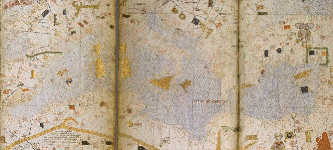EOL 3: Music, Myth, and History (Bohlman) |
|
8. Return to the Beginning of European Music History The diasporas that collapse upon Europe have in many ways led to the return to the geography that defined Europe at its beginnings: the Mediterranean. This historical and diasporic meaning of the Mediterranean is, of course, a common thread that connects the different articles in this issue of Ethnomusicology OnLine. The Mediterranean of the late twentieth century is very different from that at the beginning of European history, and it follows that the new diasporas will move along the connective routes between the Mediterranean and Europe. One of the most powerful and sweeping of these new diasporas is that from the Islamic Middle East and South Asia. Christian Europe, accordingly, undergoes remapping. There are parts of Berlin that are largely Turkish and Muslim; there are districts of Paris that are largely North African and Muslim; there are neighborhoods in London that are largely Pakistani and Muslim. The modern and postmodern case of London is particularly striking, for the growing presence of England has been the product of the collapse of the British Empire. The center, England, has now been culturally transformed by the periphery, Islamic areas of the former empire. Musically, this process had begun at the peripheries, with harmoniums and violins, and other European forms of music that became Indian and Pakistani. In Germany, the process has also begun to unfold, as the presence of Islamic cultures within Central European society now takes audible form, despite the attempts of the German Right to stem it. I wonder whether in Central Europe, too, this new Muslim transformation of the center was not inevitable. There has been considerable debate, for example, about the mosque in Germany and about its role as a place for the call to prayer (adhan) and Qur'anic recitation, both canonic vocal practices in Islam. The call to prayer in specific enters into the public sphere, where it pollutes the presumed purity of folk song and other canons of German music-making. The path of these diasporas from Islamic cultures into Europe is not yet entirely charted. There will be obstacles, and it will be necessary to cross borders of various kinds. As a diaspora, nonetheless, the growth of Islam in Europe draws the continent again toward the Mediterranean. Many forms of music-making, ranging from folk to sacred to art musics, are constructed as means of remembering. Some extend the act of remembrance even to the Mediterranean, and I should like to turn to one of these: Jewish music in the New Europe. The traces of Jewish Europe have become visible and audible again in the New Europe. In the aftermath of the Holocaust, the possibility of a surviving Jewish Europe seemed too horrendous and impossible even to consider. Older Jewish communities, say those in Vienna, are reentering history again, in Vienna's case, the history of modern Austria. With the remapping of nations in Eastern Europe Jews there recognized a moment to return to Europe, that is, to identify themselves as Jews. Jewish Europe is audible on the streets of music, that is, in the street music, where klezmer bands play and Jewish folk-dance troupes perform. Synagogue choirs tour throughout Europe, attracting Jewish and non-Jewish audiences wherever they perform. There is no absence of opportunities to hear Yiddish or Sephardic folk songs on recordings or in concert. This return to Jewish Europe, nonetheless, has been possible because of the metaphorical role of music. |
|
 Illustration Four: Catlan Atlas |
My concluding remarks bring me back to my beginning, in fact, to the very beginning, my title, which concerns itself directly with the contestation of myth and modernity, the past and the future. At issue are, yet again, the questions of history in the modern--and postmodern--Mediterranean and the presence of music in that history. Beginning and ending collapse upon each other, and history turns in on itself. The musicians of the Mediterranean whose lives and journeys the authors in this issue of EOL portray acqure a trenchant power to narrate these new myths, which nonetheless emerge from the myths that have so long formed our historical imagination of the Mediterranean. From the myths of modernity, anthropologists and historians of music can draw a new responsibility to engage in the investigation of music's presence in the future. Indeed, we can find new ways of drawing our fields of research together when we recognize the complex ways in which diaspora has recharted the course of Mediterranean music history. The contributions by my colleagues to this special issue constitute a first step in this direction. Musical anthropology must confront the dilemmas of postmodern history, and I believe the modern ethnomusicology can do just that, in fact by narrowing the distance between history observed and history lived. It is precisely this distance in the diaspora symbolized by the myths of modernity that cries out for our attention. It is the modern--even more, the postmodern--form of that distance that street musicians in the New Europe perform with their music, that refugees from the Balkans make vivid, and that guest workers who cross borders on their way from the Mediterranean to the industrial centers of northern Europe ceaselessly symbolize with their musics that belie borders altogether. It is the distance that the myths of modernity and diaspora open up. It is the distance that ethnomusicology can and must confront. |